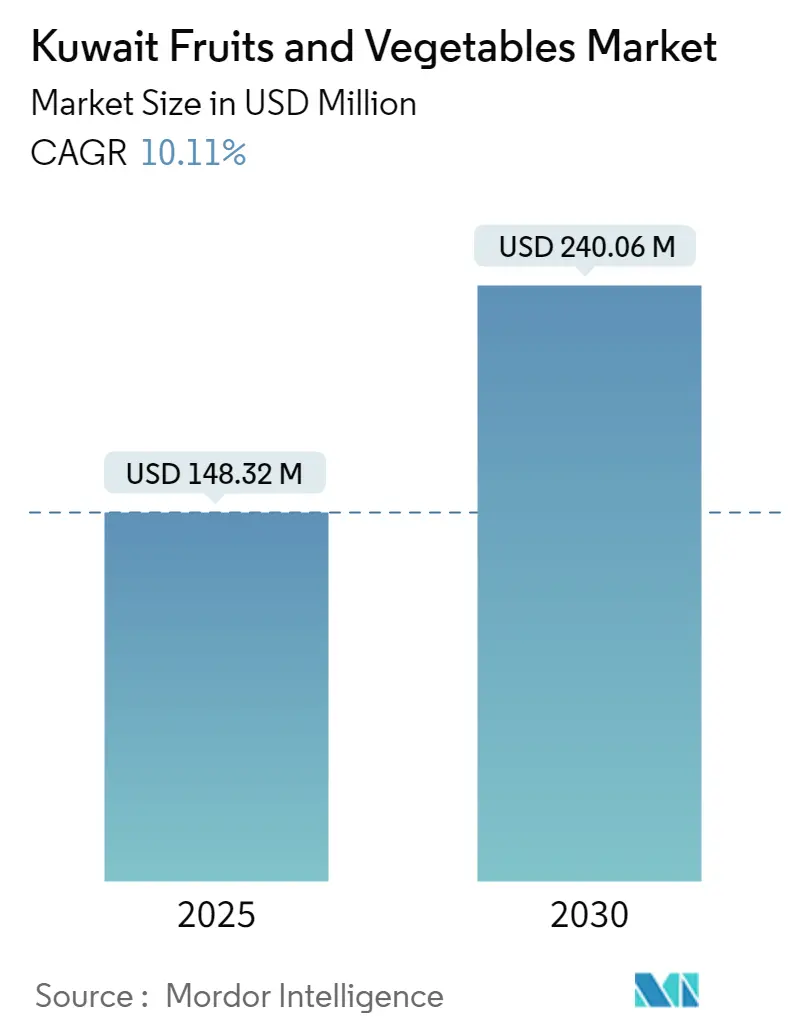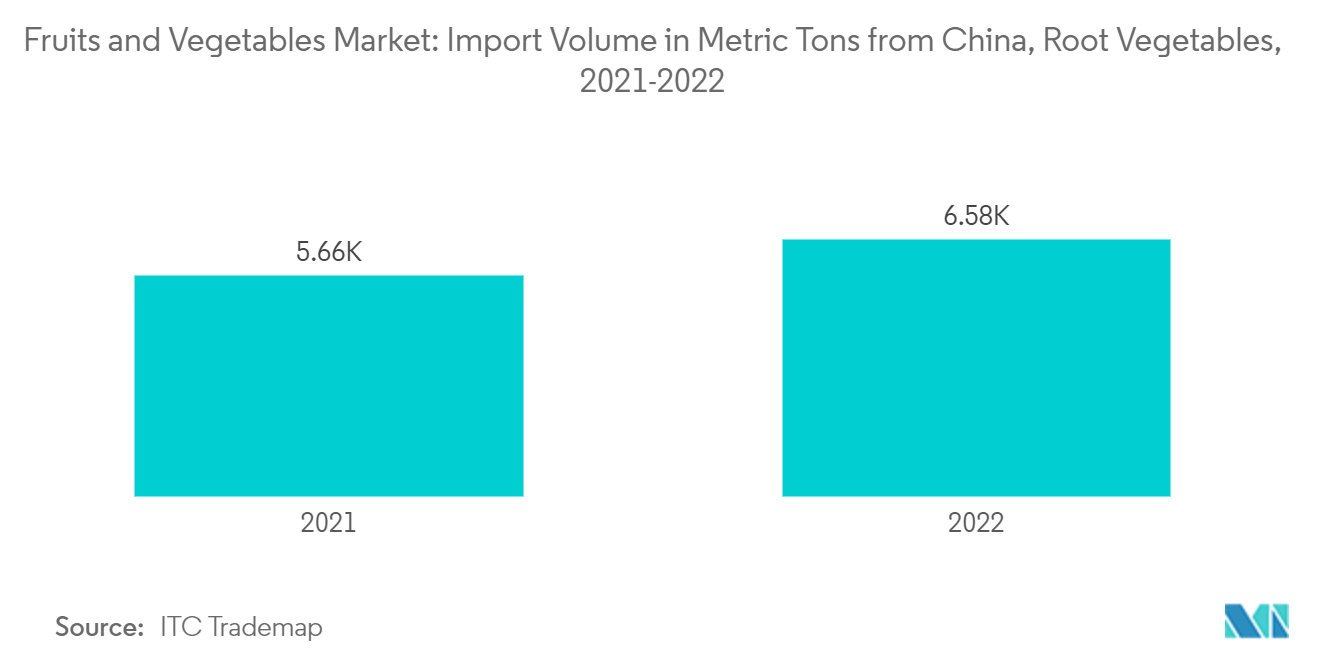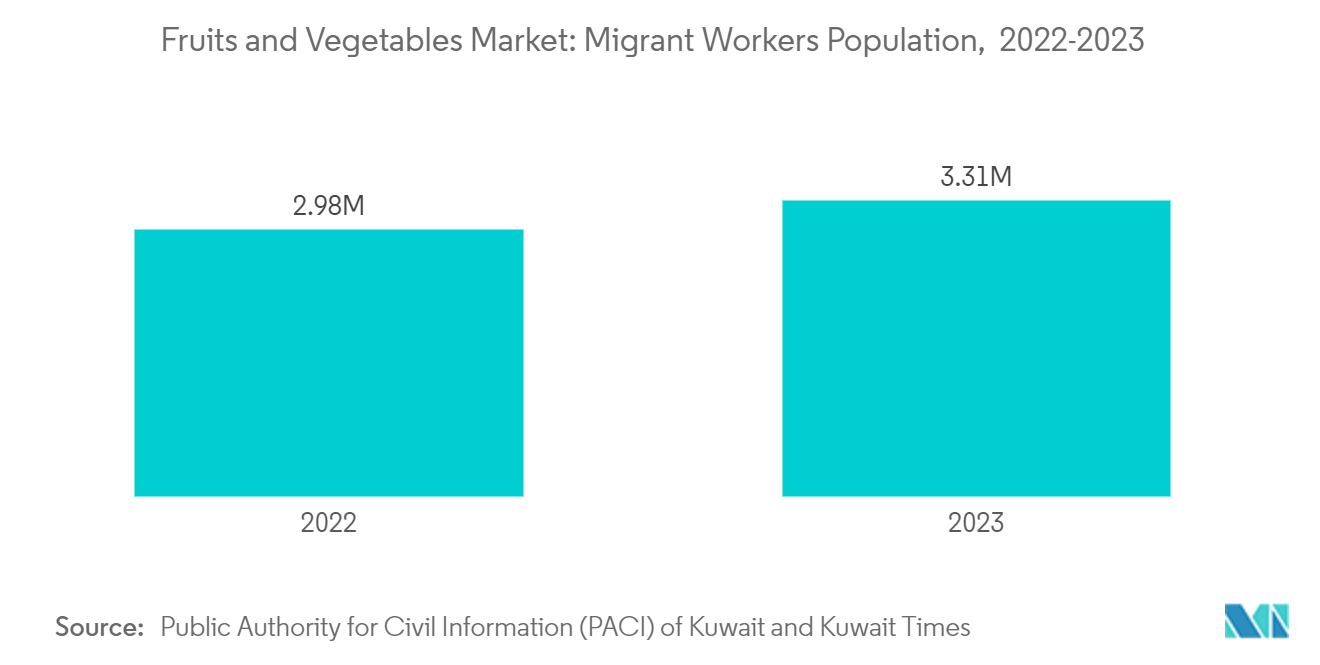Kuwait Fruits & Vegetables Market Analysis
The Kuwait Fruits & Vegetables Market size is estimated at USD 148.32 million in 2025, and is expected to reach USD 240.06 million by 2030, at a CAGR of 10.11% during the forecast period (2025-2030).
Kuwait, characterized by its arid desert landscape, has a limited capacity for cultivating fruits and vegetables. The nation experiences four distinct seasons, marked by long, hot, and dry summers followed by brief winters. Rainfall is sparse, occurring mainly in the spring and winter months. Data from the World Bank highlights that Kuwait's average annual rainfall ranges between 75 to 150 mm. Given these climatic challenges, Kuwait's agricultural output is largely confined to dates, watermelons, strawberries, tomatoes, cucumbers, and eggplants. As a result, the nation heavily relies on imports to satisfy its domestic demand for fresh produce. India, Pakistan, and Sri Lanka are the primary sources of Kuwait's fresh vegetable imports. Regarding edible fruits, Kuwait imports from the United States, South Africa, India, and Egypt. Kuwait exports fruits such as dates, figs, pineapples, and guava to neighboring countries, including Qatar, Iran, Saudi Arabia, and the United Arab Emirates.
To bolster food security and self-sufficiency, the Kuwaiti government has rolled out several initiatives, focusing on enhancing local agriculture and upgrading food infrastructure. In February 2024, Sheikh Firas Al-Mali, the Minister of Social Affairs, established an inspection team. Their mandate is to ensure that 75% of the fruit and vegetable stocks in cooperative societies are sourced from local farmers. This initiative bolsters local farmers and ensures the regulation of produce across all sales outlets.
Kuwait Fruits & Vegetables Market Trends
Import of Fruits and Vegetables to meet the Domestic Demand
Kuwait has a small agricultural sector and limited arable land, making it difficult to produce sufficient quantities of fruits and vegetables to meet the domestic demand of the rising population. The country had a population of 3,138,355 in 2023 with a total arable land of 8,000 hectares as per the World Fact Book CIA (Central Intelligence Agency). The natural water resources required for irrigation are minimal, with most water used coming from desalination plants that consume a lot of electricity. Domestic farmers cannot bear the costs as there are no subsidies for electricity.
Thus, the agricultural sector in Kuwait faces significant challenges due to harsh climatic conditions and vulnerable water and soil resources. Hence, the country mainly depends on importing fruits and vegetables. The United States, India, Egypt, and South Africa are the major exporters of fruits to the country. As per the ITC trade map, in 2022, the country's overall import value of fruits accounted for USD 486,971, with the United States and South Africa holding a significant share of 13.5% and 11.6%. Further, India, Egypt, Ecuador, and Saudi Arabia are the major exporters of fruits to the country. In addition, the Kuwaiti economy is relatively wealthy, and consumers have the purchasing power to afford imported fruits and vegetables. For instance, the country has ranked 39th among the world’s richest countries in 2024, with a GDP per capita of USD 31.72 thousand, as reported by the International Monetary Fund. Hence, the increased demand for fruits and vegetables in the country with the less favorable cultivation conditions created a market potential for imports, which is further anticipated to drive the market in the country during the forecast period.
The Influx of Migrant Workers is Expected to Propel the Market
Migrant workers from diverse nations are infusing their culinary traditions into Kuwait, leading to an increasing demand for fruits and vegetables. As the population increases due to an influx of migrant workers, the demand for produce is also expected to increase. For example, in 2023, data from the Public Authority for Civil Information (PACI) of Kuwait highlighted that migrants constitute a significant 70% of Kuwait's populace, translating to 3,313,000 out of a total of 4,859,000. The migrant population in 2023 saw an increase of 11% in comparison to 2022. Predominantly hailing from Arab nations, South Asia, Southeast Asia, and Africa, these expatriates, with a notable concentration from India and Egypt, primarily engaged in construction and service sectors. A considerable number, especially from South Asia, arrive on temporary work visas, further amplifying the demand for fruits and vegetables.
These migrant workers are given lower wages than the nationals for performing activities such as farming, harvesting, and transporting fruits and vegetables. For instance, a migrant worker earns around KWD 125 per month as per the Business & Human Rights Resource Centre Article. Many small and large souks (traditional marketplaces) and wholesale marketplaces are staffed and managed by migrant workers. They are used in operations such as sorting, grading, packing, and distribution of fruits and vegetables to markets and retailers across the country. The involvement of migrant labor in the entire supply chain of fruits and vegetables, from farming to unloading imported fruits and vegetables, resulted in a reduction of cost at every stage of the supply chain. It benefits the customers by keeping the prices affordable. Hence, these expatriates drive the market in both demand and supply aspects.
Kuwait Fruits & Vegetables Market News
- February 2024: The Ministry of Social Affairs established an inspection team to guarantee that 75% of the fruits and vegetables sold by cooperative societies are sourced from local farmers, thereby supporting them and overseeing the produce at retail outlets.
- January 2024: Under the leadership of President Musab Al-Mulla, the Union of Cooperative Societies in Kuwait launched a new initiative under the "Sahel" program to bolster price control on essential commodities, fruits, and vegetables within cooperative societies. The Sahel system is used to update prices.
Kuwait Fruits & Vegetables Industry Segmentation
Fruits and Vegetables are foods rich in vitamins, minerals, fiber, and antioxidants. They are low in calories and essential for a healthy diet.
The Kuwaiti fruit and vegetable market is segmented by product type (fresh fruits and vegetables). The report includes production analysis (volume), consumption analysis (value and volume), export analysis (value and volume), import analysis (value and volume), and wholesale price trend analysis. The report offers the market size and forecasts in terms of volume (metric tons) and value (USD) for all the above segments.
| Product Type (Production analysis (Volume), Consumption analysis (Value and Volume), Export analysis (Value and Volume), Import analysis (Value and Volume), and Price Trend analysis) | Vegetables |
| Fruits |
Kuwait Vegetables and Fruits Market Research FAQs
How big is the Kuwait Fruits & Vegetables Market?
The Kuwait Fruits & Vegetables Market size is expected to reach USD 148.32 million in 2025 and grow at a CAGR of 10.11% to reach USD 240.06 million by 2030.
What is the current Kuwait Fruits & Vegetables Market size?
In 2025, the Kuwait Fruits & Vegetables Market size is expected to reach USD 148.32 million.
What years does this Kuwait Fruits & Vegetables Market cover, and what was the market size in 2024?
In 2024, the Kuwait Fruits & Vegetables Market size was estimated at USD 133.32 million. The report covers the Kuwait Fruits & Vegetables Market historical market size for years: 2019, 2020, 2021, 2022, 2023 and 2024. The report also forecasts the Kuwait Fruits & Vegetables Market size for years: 2025, 2026, 2027, 2028, 2029 and 2030.
Our Best Selling Reports
Vegetables and Fruits in Kuwait Industry Report
Statistics for the 2025 Kuwait Fruits & Vegetables market share, size and revenue growth rate, created by Mordor Intelligence™ Industry Reports. Kuwait Fruits & Vegetables analysis includes a market forecast outlook for 2025 to 2030 and historical overview. Get a sample of this industry analysis as a free report PDF download.





